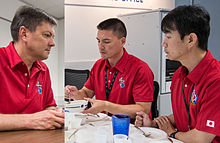 Soyuz TMA-17M flying above Typhoon Soudelor while docked to the ISS Soyuz TMA-17M flying above Typhoon Soudelor while docked to the ISS | |
| Operator | Roscosmos |
|---|---|
| COSPAR ID | 2015-035A |
| SATCAT no. | 40744 |
| Mission duration | 141 days, 16 hours and 9 minutes |
| Spacecraft properties | |
| Spacecraft type | Soyuz-TMA 11F732A47 No.717 |
| Manufacturer | Energia |
| Crew | |
| Crew size | 3 |
| Members | Oleg Kononenko Kimiya Yui Kjell N. Lindgren |
| Start of mission | |
| Launch date | 22 July 2015 21:02:45 UTC |
| Rocket | Soyuz-FG |
| Launch site | Baikonur 1/5 |
| End of mission | |
| Landing date | 11 December 2015 13:12 UTC |
| Landing site | Kazakhstan |
| Orbital parameters | |
| Reference system | Geocentric |
| Regime | Low Earth |
| Docking with ISS | |
| Docking port | Rassvet nadir |
| Docking date | 23 July 2015 02:45 UTC |
| Undocking date | 11 December 2015 09:47 UTC |
| Time docked | 141 days, 7 hours, 2 minutes |
 (l-r) Kononenko, Lindgren and YuiSoyuz programme (Crewed missions)← Soyuz TMA-16MSoyuz TMA-18M → | |
Soyuz TMA-17M was a 2015 flight to the International Space Station. It transported three members of the Expedition 44 crew to the International Space Station. TMA-17M was the 126th flight of a Soyuz spacecraft; the first having occurred in 1967. The crew consisted of a Russian commander accompanied by Japanese and American astronauts. The capsule remained docked to the space station for about five months until the scheduled departure of Expedition 45 in December 2015. Soyuz TMA-17M landed safely on the steppes of Kazakhstan on 11 December, 2015, in a rare night landing.
Crew
| Position | Crew Member | |
|---|---|---|
| Commander | Expedition 44 Third spaceflight | |
| Flight Engineer 1 | Expedition 44 First spaceflight | |
| Flight Engineer 2 | Expedition 44 First spaceflight | |
Backup crew
| Position | Crew Member | |
|---|---|---|
| Commander | ||
| Flight Engineer 1 | ||
| Flight Engineer 2 | ||
Mission Insigna
The mission patch for the mission is completely based on Apollo 17 insignia.
Gallery
-
 Soyuz TMA-17M crew photo on the second day of qualification exams. Left to right: Lindgren, Kononenko, Yui.
Soyuz TMA-17M crew photo on the second day of qualification exams. Left to right: Lindgren, Kononenko, Yui.
-
 The Soyuz booster is raised into position on the launch pad at Baikonur.
The Soyuz booster is raised into position on the launch pad at Baikonur.
-
 Launch of Soyuz TMA-17M.
Launch of Soyuz TMA-17M.
-
 Inside the capsule during launch.
Inside the capsule during launch.
-
 Soyuz TMA-17M approaches the ISS. Note the absence of one solar panel, which successfully deployed later on.
Soyuz TMA-17M approaches the ISS. Note the absence of one solar panel, which successfully deployed later on.
-
 Soyuz TMA-17M departs from the space station.
Soyuz TMA-17M departs from the space station.
-
 The Soyuz return capsule on the ground after a rare night landing.
The Soyuz return capsule on the ground after a rare night landing.
See also
References
- Планируемые полёты (in Russian). astronaut.ru. Retrieved 2012-09-04.
- astronaut.ru (2013). "Орбитальные полёты".
| Soyuz programme | |||||||||||||||||||||||||||
|---|---|---|---|---|---|---|---|---|---|---|---|---|---|---|---|---|---|---|---|---|---|---|---|---|---|---|---|
| Main topics |  | ||||||||||||||||||||||||||
| Past missions (by spacecraft type) |
| ||||||||||||||||||||||||||
| Current missions | |||||||||||||||||||||||||||
| Future missions | |||||||||||||||||||||||||||
| Uncrewed missions are designated as Kosmos instead of Soyuz; exceptions are noted "(uncrewed)". The † sign designates failed missions. Italics designates cancelled missions. | |||||||||||||||||||||||||||
| Human spaceflights to the International Space Station | ||
|---|---|---|
| See also: ISS expeditions, Uncrewed ISS flights | ||
| 1998–2004 |
|  |
| 2005–2009 | ||
| 2010–2014 | ||
| 2015–2019 |
| |
| Since 2020 |
| |
| Future | ||
| Individuals | ||
| Vehicles |
| |
| ||
| ← 2014Orbital launches in 20152016 → | |
|---|---|
| January | |
| February | |
| March | |
| April | |
| May |
|
| June | |
| July | |
| August | |
| September | |
| October | |
| November |
|
| December |
|
| Launches are separated by dots ( • ), payloads by commas ( , ), multiple names for the same satellite by slashes ( / ). Crewed flights are underlined. Launch failures are marked with the † sign. Payloads deployed from other spacecraft are (enclosed in parentheses). | |